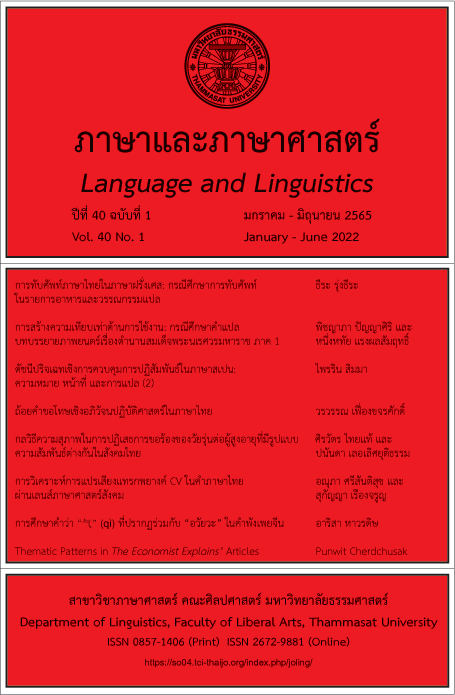ดัชนีปริจเฉทเชิงการควบคุมการปฏิสัมพันธ์ในภาษาสเปน: ความหมาย หน้าที่ และการแปล (2)
Main Article Content
บทคัดย่อ
บทความวิจัยชิ้นนี้มีวัตถุประสงค์เพื่อศึกษาความหมาย หน้าที่ และการแปลคำ ¿eh?, mira และ oye เมื่อใช้เป็นดัชนีปริจเฉทเชิงการควบคุมการปฏิสัมพันธ์ในการสนทนาภาษาสเปน จากการศึกษาพบว่า ¿eh? ใช้ต่อท้ายหน่วยถ้อยเพื่อเรียกร้องให้ผู้ฟังตอบกลับและเพื่อตรวจสอบหรือรักษาระดับความสนใจของผู้ฟัง และใช้เป็นคำถามเพื่อขอให้คู่สนทนาแสดงข้อมูลซ้ำหรืออธิบายสิ่งที่เพิ่งกล่าวไปให้กระจ่างขึ้น ส่วน mira และoye นั้นใช้เพื่อเรียกให้ผู้ฟังสนใจสิ่งที่ผู้พูดกำลังจะกล่าว โดย mira จะใช้เมื่อผู้พูดต้องการดึงให้ผู้ฟังเข้ามาสู่อาณาเขตของผู้พูดและทำความเข้าใจผู้พูด ในขณะที่ oye จะใช้เมื่อผู้พูดพยายามนำตัวเองเข้าไปยังอาณาเขตของผู้ฟังและสื่อสารข้อมูลจากมุมมองของความเกี่ยวข้องของข้อมูลนั้นกับผู้ฟังเป็นสำคัญ ในด้านการแปล พบว่ามีการใช้หน่วยภาษาในภาษาไทยที่หลากหลายเป็นคำแปลของดัชนีปริจเฉทภาษาสเปนแต่ละดัชนีที่เลือกมาศึกษา ทั้งนี้ ผู้วิจัยได้รวบรวมหน่วยภาษาดังกล่าว พร้อมทั้งตั้งข้อสังเกตและให้ข้อเสนอแนะเกี่ยวกับคำแปลที่เลือกใช้และการละไว้ไม่แปลด้วย
Article Details

อนุญาตภายใต้เงื่อนไข Creative Commons Attribution-NonCommercial-NoDerivatives 4.0 International License.
บทความทุกบทความเป็นลิขสิทธิ์ของภาษาและภาษาศาสตร์
เอกสารอ้างอิง
ฆอร์เฆ่ บูกาย. (2556). จะเล่าให้คุณฟัง (พิมพ์ครั้งที่ 3) (เพ็ญพิสาข์ ศรีวรนารถ, ผู้แปล). สำนักพิมพ์ผีเสื้อ. (ต้นฉบับพิมพ์ปี ค.ศ. 2002).
ฆอร์เฆ่ บูกาย. (2558). จะเล่าเป็นเพื่อนคุณ (พิมพ์ครั้งที่ 3) (เพ็ญพิสาข์ ศรีวรนารถ, ผู้แปล). สำนักพิมพ์ผีเสื้อ. (ต้นฉบับพิมพ์ปี ค.ศ. 2005).
โฆเซ่ หลุยส์ โอไลยโซล่า. (2540). โลกของเธอ บิเบียน่า (สว่างวัน ไตรเจริญวิวัฒน์, ผู้แปล). ฟ้าอภัย. (ต้นฉบับพิมพ์ปี ค.ศ. 1985).
โฆเซ่ หลุยส์ โอไลยโซล่า. (2546). กุ๊ชโฉ่ (พิมพ์ครั้งที่ 6) (รัศมี กฤษณมิษ, ผู้แปล). ฟ้าอภัย. (ต้นฉบับพิมพ์ปี ค.ศ. 1983).
โฆเซ่ หลุยส์ โอไลยโซล่า. (2550). สู้ เบนิโต้ สู้ (พิมพ์ครั้งที่ 3) (รัศมี กฤษณมิษ, ผู้แปล). ฟ้าอภัย. (ต้นฉบับพิมพ์ปี ค.ศ. 2002).
นววรรณ พันธุเมธา. (2559). ไวยากรณ์ไทย (พิมพ์ครั้งที่ 8). โครงการเผยแพร่ผลงานวิชาการ คณะอักษรศาสตร์ จุฬาลงกรณ์วิทยาลัย.
ปัทมา วสวานนท์. (2539). ดัชนีปริจเฉท "นะ" ในบทสนทนาแบบกันเองภาษาไทย กรุงเทพฯ [วิทยานิพนธ์ปริญญามหาบัณฑิต]. จุฬาลงกรณ์มหาวิทยาลัย.
ปิลาร์ มาเตโอส. (2544). หนิ่งงุ้นโน่ (พิมพ์ครั้งที่ 2) (สว่างวัน ไตรเจริญวิวัฒน์, ผู้แปล). สำนักพิมพ์ผีเสื้อ. (ต้นฉบับพิมพ์ปี ค.ศ. 1981).
ไพรริน สิมมา. (2564). ดัชนีปริจเฉทเชิงการควบคุมการปฏิสัมพันธ์ในภาษาสเปน: ความหมาย หน้าที่ และการแปล (1). ภาษาและภาษาศาสตร์, 39(1), 54-81.
มานูเอล ปุช. (2557). ริมฝีปากนาง (สถาพร ทิพยศักดิ์, ผู้แปล). สำนักพิมพ์ผีเสื้อ. (ต้นฉบับพิมพ์ปี ค.ศ. 1968).
มาเรีย โรซา โลโฆ. (2557). สุดขอบโลกที่ฟินิสแตร๎เร (ภาสุรี ลือสกุล, ผู้แปล). สำนักพิมพ์ผีเสื้อ. (ต้นฉบับพิมพ์ปี ค.ศ. 2005).
ลูเซีย บาเกดาโน่. (2542). ปลูกฝันไว้ในแผ่นดิน (พิมพ์ครั้งที่ 2) (รัศมี กฤษณมิษ, ผู้แปล). ฟ้าอภัย. (ต้นฉบับพิมพ์ปี ค.ศ. 1981).
วัชรพล บุพนิมิตร. (2539). ดัชนีปริจเฉทในบทสนทนาแบบกันเองของผู้พูดภาษาไทยกรุงเทพฯ [วิทยานิพนธ์ปริญญามหาบัณฑิต]. จุฬาลงกรณ์มหาวิทยาลัย.
หลุยส์ เซปุล์เบดา. (2551ก). ชายชราผู้อ่านนิยายรัก (สถาพร ทิพยศักดิ์, ผู้แปล). สำนักพิมพ์ผีเสื้อ. (ต้นฉบับพิมพ์ปี ค.ศ. 1989).
หลุยส์ เซปุล์เบดา. (2551ข). นางนวลกับมวลแมวผู้สอนให้นกบิน (สถาพร ทิพยศักดิ์, ผู้แปล). สำนักพิมพ์ผีเสื้อ. (ต้นฉบับพิมพ์ปี ค.ศ. 1996).
หลุยส์ เซปุล์เบดา. (2554). โลกสุดขอบฟ้า (สถาพร ทิพยศักดิ์, ผู้แปล). สำนักพิมพ์ผีเสื้อ. (ต้นฉบับพิมพ์ปี ค.ศ. 1989).
Baquedano, L. (2016). Cinco panes de cebada (49th ed.). Ediciones SM.
Briz Gómez, A. (1998). El español coloquial en la conversación. Esbozo de pragmagramática. Ariel.
Bucay, J. (2012). Cuenta conmigo. RBA/Del Nuevo Extremo.
Bucay, J. (2016). Déjame que te cuente. RBA Bolsillo.
Martín Zorraquino, M. A. (2010). Los marcadores del discurso y su morfología. In Ó. Loureda Lamas & E. Acín Villa (Eds.), Los estudios sobre marcadores del discurso en español, hoy (pp. 93–181). Arco Libros.
Martín Zorraquino, M. A., & Portolés, J. (1999). Los marcadores del discurso. In I. Bosque & V. Demonte (Eds.), Gramática descriptiva de la lengua española (pp. 4051–4213). Espasa Calpe.
Mateos, P. (1998). Historias de ninguno (22nd ed.). Ediciones SM.
Montañez Mesas, M. P. (2007). Marcadores del discurso y posición final: la forma ¿eh? en la conversación coloquial española. E.L.U.A., 21, 1-20. http://dx.doi.org/10.14198/ELUA2007.21.13
Olaizola, J. L. (1998). Bibiana y su mundo (18th ed.). Ediciones SM.
Olaizola, J. L. (2015). Cucho (43rd ed.). Ediciones SM.
Olaizola, J. L. (2016). Corre, Benito, corre (3rd ed.). Palabra.
Pons Bordería, S. (1998). Oye y mira o los límites de la conexión. In M. A. Martín Zorraquino & E. Montolío Durán (Eds.), Los marcadores del discurso. Teoría y análisis (pp. 213-228). Arco Libros.
Portolés, J. (2002). Marcadores del discurso y traducción. In J. García Palacios & M. T. Fuentes Morán (Eds.), Texto, terminología y traducción (pp. 145-168). Ediciones Almar.
Puig, M. (2004). Boquitas pintadas. Booket.
Rosa Lojo, M. (2006). Finisterre (2nd ed.). Sudamericana.
Sepúlveda, L. (2015a). Mundo del fin del mundo (3rd ed.). Tusquet Editores.
Sepúlveda, L. (2015b). Un viejo que leía novelas de amor (82nd ed.). Tusquet Editores.
Sepúlveda, L. (2016). Historia de una gaviota y del gato que le enseñó a volar (67th ed.). Tusquet Editores.
Tanghe, S., & Jansegers, M. (2014). Marcadores del discurso derivados de los verbos de percepción: Un análisis comparativo entre el español y el italiano. Revue Romane, 49(1), 1-31. https://doi.org/10.1075/rro.49.1.01jan


